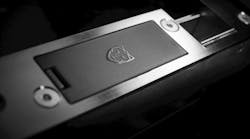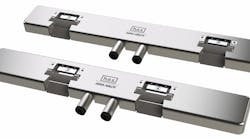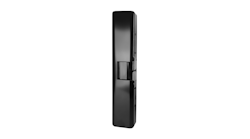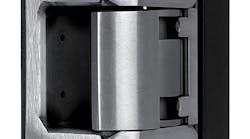Electric strikes are a familiar form of electrical door control that have been around since the late 1880s. In 1976, Lee Hanchett reconfigured the electric strike to locate the solenoid within the body of the strike instead of attached to the outside. This configuration significantly reduced technician installation challenges, leading to a parade of ongoing innovations and new applications.
Today, electric strikes are an essential component to door access control solutions. The latest technology is a wireless electric strike that features integrated Wi-Fi connectivity to the access control system, which results in reduced installation labor, time and materials for the security pro.
Traditional electric strike installations include recessing the electric strike into the door jamb or surface-mounting it to work with exit devices. Strikes integrate with many types of doors and frames, including wood, aluminum, hollow metal and glass entrances, and in many applications, such as retail, hospitality and commercial.
Strikes also can fill the demand for securing all-glass openings that have surface-mounted vertically positioned exit bars that include a latch incorporated at the top of the vertical rod. Special strikes that mount seamlessly in the door frame header are designed to work with a concealed vertical rod latch at the top of the door.
Electric Strike Selection
Identifying the right strike and the proper solution for the opening is the place to begin, starting with a detailed initial site walk-through, risk assessment and health evaluation of each opening. Every location has individual characteristics that must be evaluated, from location to materials and existing hardware.
Electric strikes can be installed in a wide range of swinging-door applications. Many different styles of electric strikes meet every vertical market, including high security, retail and residential. Cylindrical locksets, mortise locksets and deadbolts typically require an electric strike that’s recessed into the frame, which most times requires cutting into the frame or the second door of a double-door set. There also are electric strikes designed for use with exit bars and even vertically mounted Pullman latches. These strikes are “surface mounted” with minimal cutting or drilling into the frame. Surface-mounted and recessed electric strikes are mounted at the location that corresponds to the centerline of the lock’s latch.
With that in mind, here are the three things you should do to determine the right electric strike for your next project:
1. Assess the type of frame and health of the opening.
Here’s where the importance of the initial risk assessment and site survey comes in. Determine the type of frame material, whether metal, aluminum or wood, and ascertain whether the frame is hollow or concrete-filled. Examine the entire opening carefully so you know the complete makeup of door, wall, frame and surrounding space. Always investigate what’s behind the walls, because it will affect your bid. Concrete-filled frames might require additional tools and installation expertise and could add hours of labor if not planned and executed properly. Consider using no-cut electric strikes where applicable, such as in historical settings or where no field modifications are allowed by the rating of the assembly or by the fire marshal or Authority Having Jurisdiction (AHJ) because of existing codes and fire ratings.
Assess the health of the door and frame and any existing hardware. Consider whether any frame or door irregularities can be remedied or fixed before electric strike installation. This can be assessed by viewing the area from the hinge side of the opening. Do you see a one-eighth-inch gap around the opening and between doors when surveying double doors? As part of the site survey, evaluate how the door opens and closes from both sides, whether it binds or is prone to preload conditions from heating-and-cooling systems, other air penetration, weather-related expansion and contraction or exposure to humidity and moisture. Other issues might arise from a door sagging or a twisted frame if these aren’t assessed initially. The site survey determines a healthy or unhealthy opening and the strike-to-lockset bond.
Preloading pressure is present at the opening when the door hardware latch presses against the strike on the frame. After you perform a deep dive into the specifics of the opening, you can give the user a solution that mitigates preload situations or other field-specific challenges.
2. Determine whether the door assembly has special requirements.
Fire ratings and meeting or exceeding all applicable fire and building codes apply to electric strike installation and affect the lifesaving properties of door assemblies. Fire-rated openings often are required in breezeways and corridors, areas that have hazardous chemical storage or locations that have machinery or high voltage. Identify the fire-rated openings at the premises and check the labels and listings on frames, doors and other areas to make sure you adhere to code. The most applicable standard for these assemblies is NFPA 80, Standard for Fire Doors and Other Protective Openings and International Code Council (ICC) requirements.
Door modifications performed on a fire-rated assembly must be performed per manufacturer-approved standards and by individuals or companies trained to perform the modifications. When modifying the door through the addition of an electric strike, ensure that the strike carries the same UL fire-rating certification as the assembly’s existing fire rating, which is found most commonly on the frame label. Any field modifications must be performed in a manner that doesn’t void that listing. The AHJ might not allow any field modifications or cuts to the fire-rated assembly. In that case, fire-rated no-cut strikes are available. Always ask questions and check with the local building or fire authority before putting any products to bid.
Electric strikes also might be certified for windstorm applications per ANSI A250.13-2003. ANSI A250.13-2003 is a standard for the testing and rating of products that might be used with other components of an exterior swinging door. These doors are commonly found in areas that might be subject to excessive (hurricane) winds, including the Gulf of Mexico and the Atlantic seaboard. Excessive winds per the ANSI A250.13-2003 range from 110 to 150 mph.
Other special conditions to note are whether the strike will be subject to weather or inclement climates, because some strikes are rated for outdoor applications as well as for UL 1034, Standard for Safety for Burglary-Resistant Electric Locking Mechanisms.
3. Identify and test existing door hardware.
It isn’t unusual for facilities to have multiple openings that have different types of doors and frames. So, access control options for each opening will have their own characteristics. Existing locking hardware determines the compatible electric strike and overall function of the opening.
Locks that work with electric strikes include bored/cylindrical, mortise, panic exit devices, narrow-stile latchbolts, unit locks, deadbolts and hook bolts. When testing, open and close the door numerous times, from both sides of the door, to make sure that the entire assembly functions correctly, including the existing latching mechanism. Identify any pre-existing conditions, damage or preload occurrences. In addition to the type of locking configuration, determine the type and length of the existing latch, dead (guard) latch or bolt that will interact with the electric strike. To further assess, look at the door opening for elements such as a center mullion, whether it’s fire-rated, the length of the latch and the headspace between the bar and mullion.
Faceplates also are a consideration, and they come in all sizes and shapes, which makes it important to have the right faceplate that integrates seamlessly with the many types of mortise locks on the market as well as the door frame.
There is an electric strike for almost every type of locking application. Surveying and testing the opening leads to identifying critical factors, which can affect the successful implementation of an electric strike as an electronic access control locking solution.
Rodger Schmidt, CAI, AFDI, is an ASSA ABLOY technical product trainer. He provides continuing education, technical training, webinars and other instruction to the electronic security hardware, door access and locking solutions industries. He can be reached at [email protected].






